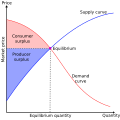Talk:American Century
| This article is rated C-class on Wikipedia's content assessment scale. It is of interest to the following WikiProjects: | ||||||||||||||||||||||||||||||||||||||||||||||||||||||
| ||||||||||||||||||||||||||||||||||||||||||||||||||||||
Not only a US term
[edit]I reverted an edit that the "American Century is only a US term because the term American century is' known outside the US. Googling "American Century" and restricting to .uk, .fr, .de (that is, United Kingdom, French, and German) domains gives 26100, 707, and 12000 hits, respectively. The BBC, a UK news service, did a program known as the "American Century," in which it makes the claim that "The Twentieth Century was undoubtedly the American century" [1]. —Lowellian (talk) 10:09, May 1, 2005 (UTC)
See also Talk:20th century. —Lowellian (talk) 12:02, May 1, 2005 (UTC)
Chinese Century?
[edit]We have an Indian Century article, and business magazines frequently mention a "Chinese Century", shouldn't such an article exist?
- Maybe. Write one! Greyfedora 00:09, 8 September 2006 (UTC)
- Just be mindful that, so far, there's been no pivotal moment, with enduring outcomes, in which China has fundamentally surpassed the United States to achieve global dominance -- such as when the U.S. economy surpassed the British Empire's in 1916, nor the American-enabled / stalemate-breaking Allied victory in World War I. (Note that the U.S. emerged relatively unscathed in that war, compared to Britain and the rest of Europe. So, as European powers struggled to recover, the U.S. surged ahead).
- Such a clear, defining event -- demonstrating Chinese global dominance -- has not yet happened, so the U.S., for the moment, remains the world's leading economic (and arguably military) power, and perhaps still principal donor to nations abroad (though Chinese foreign loans muddy those stats). U.S. global importance may decline with the new (Trump) administration hell-bent on U.S. global DIS-engagement -- thus leaving world dominance to China (and partially, Russia). But that's a yet-to-happen event.
- ~ Penlite (talk) 18:25, 19 January 2025 (UTC)
External links modified
[edit]Hello fellow Wikipedians,
I have just modified 3 external links on American Century. Please take a moment to review my edit. If you have any questions, or need the bot to ignore the links, or the page altogether, please visit this simple FaQ for additional information. I made the following changes:
- Added archive https://web.archive.org/web/20140629045949/http://www3.wooster.edu/History/jgates/book-ch3.html to http://www3.wooster.edu/History/jgates/book-ch3.html
- Added archive https://web.archive.org/web/20090507211238/http://www.sss.gov/induct.htm to http://www.sss.gov/induct.htm
- Added archive https://web.archive.org/web/20090625085003/http://www.iie.com/publications/papers/paper.cfm?ResearchID=486 to http://www.iie.com/publications/papers/paper.cfm?researchid=486
When you have finished reviewing my changes, you may follow the instructions on the template below to fix any issues with the URLs.
This message was posted before February 2018. After February 2018, "External links modified" talk page sections are no longer generated or monitored by InternetArchiveBot. No special action is required regarding these talk page notices, other than regular verification using the archive tool instructions below. Editors have permission to delete these "External links modified" talk page sections if they want to de-clutter talk pages, but see the RfC before doing mass systematic removals. This message is updated dynamically through the template {{source check}} (last update: 5 June 2024).
- If you have discovered URLs which were erroneously considered dead by the bot, you can report them with this tool.
- If you found an error with any archives or the URLs themselves, you can fix them with this tool.
Cheers.—InternetArchiveBot (Report bug) 16:11, 3 July 2017 (UTC)
Trump and the American Century
[edit]The page mentions an article blaming Trump for the end of the American Century, isn't such an article very biased to be placed on Wikipedia? — Preceding unsigned comment added by 177.98.163.135 (talk) 00:59, 14 February 2018 (UTC)
- Agreed 100%, don't take it seriously since it's common in Wokepedia. 177.38.210.52 (talk) 20:48, 19 March 2024 (UTC)
Wikipedia should strive to debunk the Chinese century idea actively, we have population pyramids and we can see a China in decline
[edit]I am fucking sure someone has written on this.
- C-Class Economics articles
- Mid-importance Economics articles
- WikiProject Economics articles
- C-Class International relations articles
- Mid-importance International relations articles
- WikiProject International relations articles
- C-Class Trade articles
- Mid-importance Trade articles
- WikiProject Trade articles
- C-Class United States articles
- Mid-importance United States articles
- C-Class United States articles of Mid-importance
- C-Class United States History articles
- Mid-importance United States History articles
- WikiProject United States History articles
- WikiProject United States articles
- C-Class history articles
- Unknown-importance history articles
- WikiProject History articles






